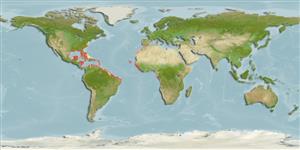Environment: milieu / climate zone / depth range / distribution range
Écologie
marin; saumâtre récifal; profondeur 0 - 5 m (Ref. 3723). Subtropical; 41°N - 13°S, 98°W - 14°E
Western Atlantic: New York, USA and northern Gulf of Mexico to Brazil (Ref. 7251); including the Caribbean Sea (Ref. 3723). Eastern Atlantic: from Morocco to the Canary Islands (Ref. 57227) and in the Gulf of Guinea from Victoria, Nigeria to south to Luanda, Angola (Ref. 4497). Reported from Côte d'Ivoire (Ref. 28587, 57227).
Taille / Poids / Âge
Maturity: Lm ? range ? - ? cm
Max length : 40.0 cm TL mâle / non sexé; (Ref. 3633); common length : 35.0 cm TL mâle / non sexé; (Ref. 3633)
Épines dorsales (Total) : 0; Rayons mous dorsaux (Total) : 11 - 15; Épines anales: 0; Rayons mous anaux: 10 - 13. Diagnosis: body elongate; lower jaw forming long, narrow beak; upper jaw short, triangular and scaled; absence of scales on snout; no preorbital crest between eye and nasal pit; pelvic fins abdominal; dorsal and anal fins placed far back on body and spineless; caudal fin deeply forked (Ref. 57227).
An inshore, surface-dwelling fish which forms sizeable schools (Ref. 3723). Feeds on small fishes and plankton (Ref. 3723). Mainly used as bait for offshore game fishes such as sailfishes and marlins; utilized as a food fish in the West Indies (Ref. 3723). Minimum depth range from Ref. 84211.
Life cycle and mating behavior
Maturities | Reproduction | Spawnings | Egg(s) | Fecundities | Larves
Collette, B.B. and N.V. Parin, 1990. Hemiramphidae. p. 579-582. In J.C. Quero, J.C. Hureau, C. Karrer, A. Post and L. Saldanha (eds.) Check-list of the fishes of the eastern tropical Atlantic (CLOFETA). JNICT, Lisbon; SEI, Paris; and UNESCO, Paris. Vol. 2. (Ref. 4497)
Statut dans la liste rouge de l'IUCN (Ref. 130435)
Menace pour l'homme
Harmless
Utilisations par l'homme
Pêcheries: intérêt commercial mineur; appât: usually
Outils
Articles particuliers
Télécharger en XML
Sources Internet
Estimates based on models
Preferred temperature (Ref.
123201): 21.1 - 28.1, mean 27.2 °C (based on 1007 cells).
Phylogenetic diversity index (Ref.
82804): PD
50 = 0.5005 [Uniqueness, from 0.5 = low to 2.0 = high].
Bayesian length-weight: a=0.00339 (0.00169 - 0.00679), b=3.09 (2.92 - 3.26), in cm total length, based on LWR estimates for this species & Genus-body shape (Ref.
93245).
Niveau trophique (Ref.
69278): 3.9 ±0.3 se; based on diet studies.
Résilience (Ref.
120179): Haut, temps minimum de doublement de population inférieur à 15 mois (Preliminary K or Fecundity.).
Fishing Vulnerability (Ref.
59153): Low to moderate vulnerability (30 of 100).
Nutrients (Ref.
124155): Calcium = 79.2 [27.5, 252.2] mg/100g; Iron = 0.831 [0.317, 2.037] mg/100g; Protein = 19.3 [16.7, 21.8] %; Omega3 = 0.188 [0.071, 0.570] g/100g; Selenium = 15.3 [5.2, 42.4] μg/100g; VitaminA = 27.3 [5.6, 150.6] μg/100g; Zinc = 1.02 [0.54, 1.80] mg/100g (wet weight);
